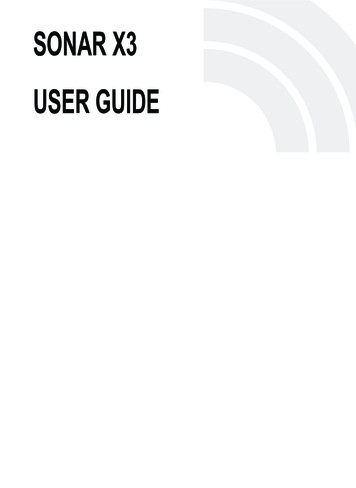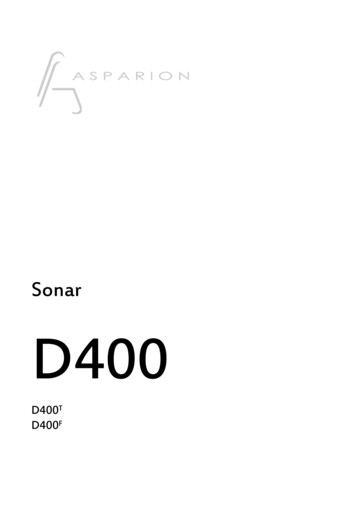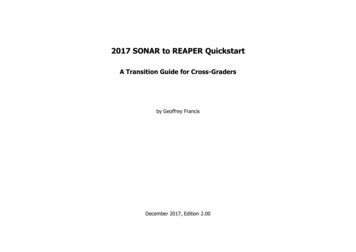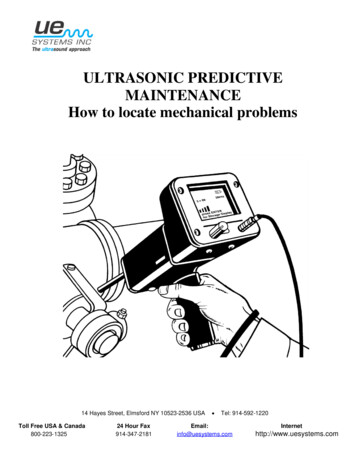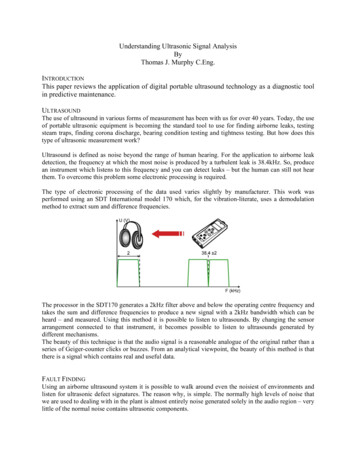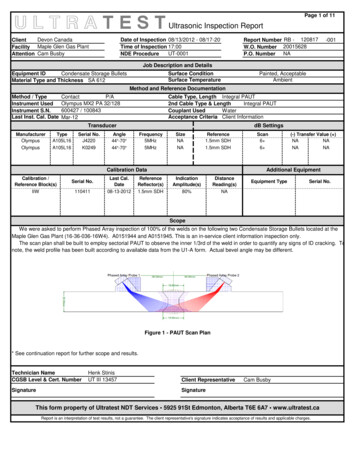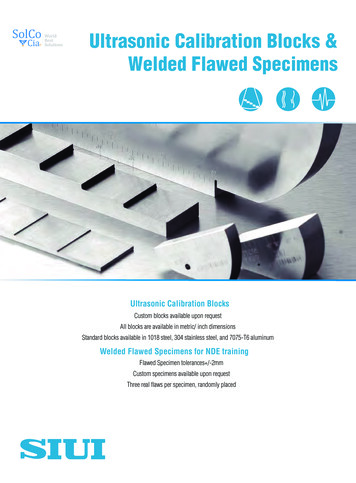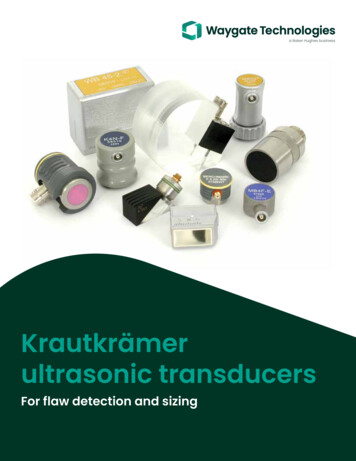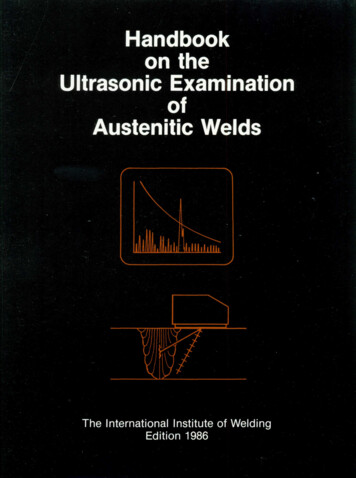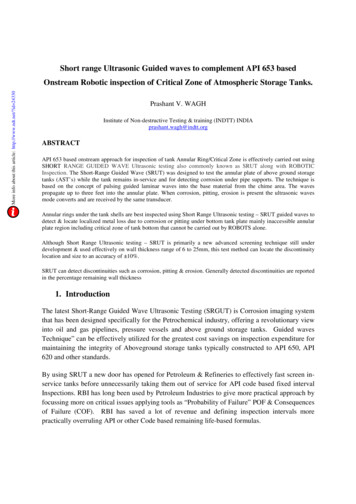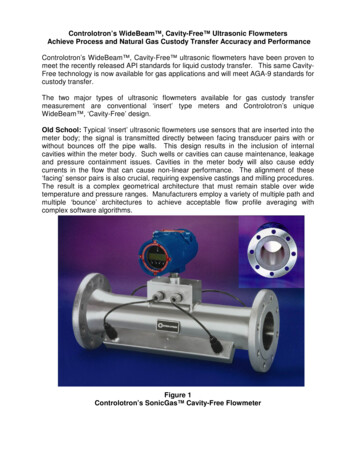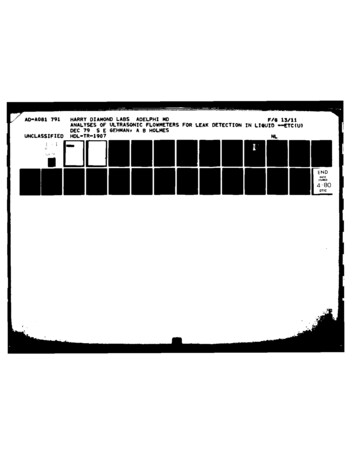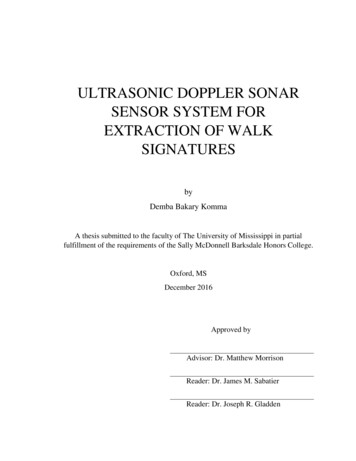
Transcription
ULTRASONIC DOPPLER SONARSENSOR SYSTEM FOREXTRACTION OF WALKSIGNATURESbyDemba Bakary KommaA thesis submitted to the faculty of The University of Mississippi in partialfulfillment of the requirements of the Sally McDonnell Barksdale Honors College.Oxford, MSDecember 2016Approved byAdvisor: Dr. Matthew MorrisonReader: Dr. James M. SabatierReader: Dr. Joseph R. Gladden
c 2016Demba Bakary KommaALL RIGHTS RESERVEDii
AcknowledgmentsI will like to thank my thesis advisor Dr. Matthew Morrison for his guidance incompiling my research work, and the writing of this thesis. Dr. Morrison taught meon the fundamentals on writing a good thesis, and prepared me well for my defense. Iam grateful to Dr. James Sabatier for being a mentor to me for the past three years,and for serving on my thesis committee. Dr. Sabatier taught me the research process,and helped explain the mathematical and physical concepts of using ultrasonic sensorsto extract Doppler features. The experiments done in my research would not havebeen possible without his support, and that of his company SOAIR LLC. I used theSOAIR LLC labs for most of the experiments that I did for my research. I will like tothank my professors for their guidance and knowledge that they gave me which helpedin completing this research project. I am thankful to Dr. Gladden for being one ofmy readers, and serving on my defense committee. Finally I am eternally grateful tomy family for the sacrifices they took to make sure I had a good education.iii
AbstractIn this work, a portable low cost sensor system is designed for the extractionof walking signatures in humans using the principle of Ultrasonic Doppler Sonar(UDS). UDS involves the use of two ultrasonic transducers acting as a transmitterreceiver pair. The transmitter produces a continuous ultrasonic signal at a specificfrequency to be broadcasted onto a moving target, while the receiver will perform afrequency shift on the reflected signal in relation to the movement of the target. Thesensor system used in this work is comprised of a frequency generator that drives thetransducer with a 40 kHz sine wave and a data acquisition device. Signal processingmethods were implemented on the received data to extract and analyze the Dopplerfeatures of a human walk.Data was initially collected using a function generator which produced the transmitted 40 kHz signal together with Measurement Computing WaveBook-516E dataacquisition measurement hardware. To make the system portable, the design was simplified using the National Instruments USB-6216 Data Acquisition (DAQ) for boththe transmitted signal and saving the received sampled data. The WaveView data acquisition software was used to control the WaveBook DAQ while a LabView programwas written to interface with the NI USB-6216 hardware. The primary objective ofimplementing the sensor system is to automate the data collection without the useof a computer, which the use of NI data acquisition made possible, but the systemparts were expensive and needed the use of a laptop to manage the process.A microprocessor, together with an Analog to Digital Converter (ADC) and aDigital to Analog Converter (DAC), were tested for generating the driving transmitiv
ting signal and the collection of the data. The TI C6748 digital signal processors onthe Texas Instruments OMAP-L138 Development Kit was the chosen processor as itis a floating-/fixed-point DSP with up to 456 MHz clock speed, the access to standardinterfaces on the development kit, and the availability of software development kits,drivers, and algorithm libraries for fast development.v
1 Literature Survey12 Operation of Ultrasonic Doppler System42.1Principle of Operation of the UDS . . . . . . . . . . . . . . . . . . . .42.2IQ Demodulation . . . . . . . . . . . . . . . . . . . . . . . . . . . . .52.3Spectrograms . . . . . . . . . . . . . . . . . . . . . . . . . . . . . . .63 Components of the UDS Sensor System83.1Ultrasonic Transducers . . . . . . . . . . . . . . . . . . . . . . . . . .83.2Signal Generator . . . . . . . . . . . . . . . . . . . . . . . . . . . . .93.3Pre-Amplifier . . . . . . . . . . . . . . . . . . . . . . . . . . . . . . .103.4Data Acquisition System . . . . . . . . . . . . . . . . . . . . . . . . .114 Demodulation Methods134.1Experimental Setup . . . . . . . . . . . . . . . . . . . . . . . . . . . .134.2Data Analysis . . . . . . . . . . . . . . . . . . . . . . . . . . . . . . .144.3Results . . . . . . . . . . . . . . . . . . . . . . . . . . . . . . . . . . .165 Validation of UDS Sensor System5.1Experimental Setup . . . . . . . . . . . . . . . . . . . . . . . . . . . .vi1818
5.2Data Analysis . . . . . . . . . . . . . . . . . . . . . . . . . . . . . . .185.3Results . . . . . . . . . . . . . . . . . . . . . . . . . . . . . . . . . . .196 Automatic UDS Sensor System6.124Hardware Components . . . . . . . . . . . . . . . . . . . . . . . . . .246.1.1Passive Infrared Sensor . . . . . . . . . . . . . . . . . . . . . .246.1.2MATSUN/PAN EFR-RC40K transducers. . . . . . . . . . .256.1.3Analog Modules Model 351A-3 Amplifier . . . . . . . . . . . .256.1.4MINMAX ABF-04D15 AC/DC Power Module . . . . . . . . .256.1.5NI USB-6216 DAQ Device . . . . . . . . . . . . . . . . . . . .266.2LabVIEW Software Program . . . . . . . . . . . . . . . . . . . . . . .266.3System Test . . . . . . . . . . . . . . . . . . . . . . . . . . . . . . . .287 Experimental Tests On Gait Features297.1Doppler Features of a Normal Walk . . . . . . . . . . . . . . . . . . .297.2Effects of Location of Sensors . . . . . . . . . . . . . . . . . . . . . .317.3Effects of Feet Noise . . . . . . . . . . . . . . . . . . . . . . . . . . .347.4Effects of Swinging Arms . . . . . . . . . . . . . . . . . . . . . . . . .377.5Multipath Doppler Effect . . . . . . . . . . . . . . . . . . . . . . . . .418 Using Microprocessors to Make a Data Acquisition System458.1Test for Signal Generation . . . . . . . . . . . . . . . . . . . . . . . .468.2Test for Sampling signals . . . . . . . . . . . . . . . . . . . . . . . . .479 Conclusion and Future Work4910 Appendix5110.1 Appendix A . . . . . . . . . . . . . . . . . . . . . . . . . . . . . . . .5110.2 Appendix B . . . . . . . . . . . . . . . . . . . . . . . . . . . . . . . .55vii
List of Figures3.1Ultrasonic transducers collocated in a plastic box . . . . . . . . . . .94.1Spectrogram Obatined from Direct Demodulation . . . . . . . . . . .154.2Spectrogram Obatined from IQ Demodulation . . . . . . . . . . . . .155.1Pendulum at 1 m away and 10 cm displacement-UDS Sensor . . . . .205.2Pendulum at 1 m away and 10 cm displacement-Radar Sensor . . . .215.3Pendulum at 2 m away and 40 cm displacement-UDS Sensor . . . . .215.4Pendulum at 2 m away and 40 cm displacement-Radar Sensor . . . .225.5Pendulum at 4 m away and 10 cm displacement-UDS Sensor . . . . .225.6Pendulum at 4 m away and 10 cm displacement-Radar Sensor . . . .236.1Graphical Representation of UDS sensor system . . . . . . . . . . . .276.2Spectrogram of pendulum swing . . . . . . . . . . . . . . . . . . . . .287.1Subject walking away from transducer . . . . . . . . . . . . . . . . .307.2Subject walking towards transducer . . . . . . . . . . . . . . . . . . .317.3Sensors at feet level . . . . . . . . . . . . . . . . . . . . . . . . . . . .327.4Sensors at knee level . . . . . . . . . . . . . . . . . . . . . . . . . . .337.5Sensors at waist level . . . . . . . . . . . . . . . . . . . . . . . . . . .337.6Leg Swing with ground contact . . . . . . . . . . . . . . . . . . . . .357.7Subject walking with shoes . . . . . . . . . . . . . . . . . . . . . . . .367.8Subject walking with socks . . . . . . . . . . . . . . . . . . . . . . . .367.9Arm swing three footsteps away . . . . . . . . . . . . . . . . . . . . .387.10 Arm swing six footsteps away . . . . . . . . . . . . . . . . . . . . . .39viii
7.11 Arm swing nine footsteps away . . . . . . . . . . . . . . . . . . . . .397.12 Subject walking with both hands inside . . . . . . . . . . . . . . . . .407.13 Subject walking with one hand inside . . . . . . . . . . . . . . . . . .407.14 Pendulum swing in lab without foam . . . . . . . . . . . . . . . . . .427.15 Pendulum swing in lab with foam . . . . . . . . . . . . . . . . . . . .437.16 Stationary Pendulum . . . . . . . . . . . . . . . . . . . . . . . . . . .437.17 Pendulum swing in Anechoid Chamber without foam . . . . . . . . .447.18 Pendulum swing in Anechoid Chamber with foam . . . . . . . . . . .448.1TI OMAP-L138 Development Kit(LCDK) with XDS200 JTAG . . . .468.21 kHz sine wave generated from TI C6748 and TLC5616 DAC . . . .478.31000 samples of 1 kHz sine wave sampled with TL4541 ADC . . . . .48ix
AbbreviationsACAlternating currentADCAnalog to Digital ConverterBNCBayonet NeillConcelmanCCSCode Composer StudioCSVComma separated valuesDACDigital to Analog ConverterDAQData Acquisition SystemDCDirect currentDSPDigital Signal ProcessorFFTFast Fourier TransformFMFrequency ModulatedI(t)In-phase signalIDEIntegrated Development EnvironmentJTAGJoint Test Action GroupkS/skilo samples per secondNINational InstrumentsPIRPassive InfraredQ(t)Quadrature signalRTOSReal Time Operating Systemx
SDSecure Digital cardSDKSoftware Development KitSPISerial Peripheral InterfaceSRSStanford Research SystemsSTFTShort Time Fourier TransformTITexas InstrumentsUDSUltrasonic Doppler Sonarxi
1.Literature SurveyUltrasonic Doppler Sonar (UDS) sensors have been used in a variety of applications such as in range finding [1], collision detection [2], object recognition [3], andhuman motion detection [4]. A continuous wave radar system for human gait recognition was done through the use of low cost microwave sensors and the use of anoscillator to transmit a stable continuous wave signal on to a moving object [5]. Thereceived signal from the object corresponds with the Doppler frequency of the movingtarget. The reflected signal is then mixed with the transmitted signal to remove thecarrier, converting into baseband which is digitalized using a data acquisition modulesand saved onto a laptop. This method was applied to a person walking towards andaway from the sensor system as the moving target. The reflected signal from a person walking will be mainly from the legs, torso and the arm with a constant Dopplershift for a person walking at a constant velocity. A short-time Fast Fourier Transform (SFFT) was used to form spectrograms to extract the velocity component ofthe human motions which were used for gait recognition and differentiation of humanmotion from animal motion.A similar approach using the same principles was used in [6], but used ultrasonicsensors to extract walking signatures in humans using different Doppler signatureextraction methods. An UDS was constructed using two ultrasonic sensors with aresonance frequency of 40 kHz. A signal generator was used to transmit a 40 kHzsine wave on one of the sensors while the other was used as a receiver for the reflectedsignal from a human walking. The data was captured using a Data Acquisition(DAQ) hardware and stored onto a disk and MATLAB was used for analysis. Doppler1
signature extractions methods that can be used for the ultrasonic Doppler sonarinclude direct demodulation, digital baseband demodulation, analog down-conversionof reflected signal and analog baseband demodulation.Direct Demodulation of the reflected signal is a Fast Fourier Transform (FFT)method for analyzing the Doppler signatures of the human walking body components.The received signal is digitalized using the DAQ hardware at a sampling rate thatsatisfies the Nyquist criterion. FFT analysis of the sampled data and the spectrogramplot shows the Doppler signature of the subject. While this is a fast method inextraction of the Doppler signatures, it is inefficient in terms of storage as the samplingrate must be high enough to satisfy the Nyquist criterion, and it has a poor frequencyresolution. Digital baseband demodulation of the reflected signal converts the receivedsignal into baseband I(t) and Q(t) by multiplying it with the carrier signal and ashifted version of the carrier. It is low-pass filtered and the resulting componentscan be decimated before combining to form a complex Doppler signal. The downsampling that can be done is an advantage over the direct demodulation method asit can be helpful in saving storage and the ability at working at lower frequencies.The spectrogram of the down-sampled data is processed to analyze the features at abetter resolution.A key component of the design of ultrasonic sonar sensor systems is data acquisition hardware used for either generating the transmitting signal, sampling thereceived reflected signal or both. The WaveBook DAQ module can be used for sampling of the received signal. It has eight data acquisition channels and can sampledata up to 1 MHz [7]. It has to be interfaced with a software on a laptop thancontrols the sampling requirements. The WaveBook is also limited as it cannot generate signals which brings the need for a frequency generator in making the system,a disadvantage in designing a portable acquisition system as a different module or afrequency generator circuit has to be used to produce the transmitting signal. An2
other disadvantage is that the WaveBook will need a laptop to control the hardwareand save the collected data individually which makes it impossible to automate thecollection of the data. The received sampled data cannot be down-sampled beforesaving, thereby leading to inefficiency of storage.The NI USB-6216 DAQ module has analog outputs together with sixteen channels analog inputs that can be used for sampling data up to 400 kS/s [8]. The analogoutputs can be used for generating a transmitting signal to drive the transmittingtransducer. A LabVIEW program was written to control the hardware, giving theflexibility of converting the received signal to baseband down-sampled
pli ed using the National Instruments USB-6216 Data Acquisition (DAQ) for both the transmitted signal and saving the received sampled data. The WaveView data ac-quisition software was used to control the WaveBook DAQ while a LabView program was written to interface with the NI USB-6216 hardware. The primary objective of
